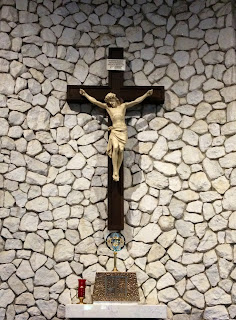This Sunday’s reading from Revelation is a bit like a
puzzle, because it’s arranged in a very particular way – as a chiasmus – in order to highlight a special theme. The word chiasmus
is based on the Greek letter X (chi, as in the “chi-rho” that is used to
represent Christianity in the image above), and so a chiasmus happens when you
have elements in a sentence arranged in a kind of “X” form. For example:
Advertisers and politicians are fond of this form because a
chiasmus tends to stick in people’s brains; recall John F. Kennedy’s “Ask not
what your country can do for you, ask what you can do for your country.” (Mae West was fond of them, too: “I’d rather be looked over than overlooked.”)
We find examples of chiasmus in the Bible as well: “Whoever exalts himself will be humbled, and
whoever humbles himself will be exalted” (Matthew 23: 11-12). But a chiasmus can also have multiple
elements, creating a kind of series of overlapping X’s; this week’s reading
from Revelation is an example of that:
a. a new heaven and a
new earth
b. former heaven and former earth had passed
away
c. the sea (i.e. chaos) was no more
d. the holy city is God’s bride
d. God’s dwelling is with the human race
c. no more death or mourning
b. the old order has passed away
a. “Behold, I make
all things new.”
If you arranged these in two parallel lines and connected like letters, you would have 2 crosses or X's made of 4 crossing lines:
a. b. c. d.
d. c. b. a.
In the example from Revelation, the most important
element is the central one: the focus is on the
marriage-like union of God with humanity, where humanity serves as the bride
and God dwells with us.
Why use such a complicated form? Well, recall that most Biblical texts were
first part of an oral tradition, which meant that “tricks” like chiasmus could
be very helpful in helping speakers remember all the little bits of the Word they were to proclaim. In the case of
the author of Revelation, the message is a very important one indeed: God is
with us, now and always, thanks to the new order established by the death and
rising of Jesus. It is a message to
celebrate, once we’ve cracked the puzzle of the chiasmus!
Image source 1
Image source 2






